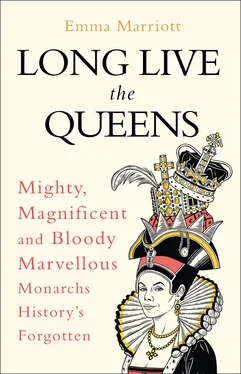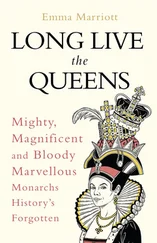When it came to her innermost circle, Wu clearly maintained a reign of terror, but her responsibilities also lay with the vast empire of China and the 50 million people who lived on its mountains, lush fields and everywhere in between. Wu did this with real efficiency, employing bureaucratic officials largely based on talent rather than social standing, and increasing the number of government posts filled by civil servants and scholars, who were required to pass a rigorous exam, rather than by those of noble birth. Her government helped to stabilise the Tang Empire, previously torn apart by civil war and under threat from ethic groups in the north and west, and under her aegis the empire was relatively fertile and prosperous. Between 655 and 675, military leaders that were chosen by Wu also conquered Korea, which considerably expanded the influence of the Chinese state, and she welcomed ambassadors from as far away as the Byzantine Empire.
In 683 Gaozong died and was succeeded by his and Wu’s son, Li Xian, known as the Zhongzong Emperor. He was married to a woman who tried to exert as much influence over Li Xian as Wu herself, which led to Wu swiftly deposing and exiling Li Xian and installing her second son, Li Dan, in 684, although his rule was largely nominal and she continued to govern in his stead. Crushing a rebellion in the south by a loyal army, Wu also maintained an efficient secret police, installing a series of copper boxes in the capital in which citizens could post anonymous denunciations of one another.
In 690, Wu took the ultimate step: at the age of sixty-five she usurped the throne itself and declared herself Empress Regnant of the newly declared ‘Zhou Dynasty’, moving the capital to Luoyang in the west of Henan province. As the traditional Chinese order of succession normally barred women from ascending the throne, Wu was determined to sweep away all opposition and continued making use of the secret police. She also took steps to elevate the status of Buddhism as the favoured state religion, over that of Taoism and Confucianism, which had strongly held views against female rule. She ordered every district to set up a Buddhist temple and instigated various visual representations of the Buddha, adding to those built at the grottoes at Longmen near Luoyang – where there is a colossal statue called the Grand Vairocana Buddha, which is believed to have been carved in Wu’s own likeness.
In the last years of her life, Wu made two young courtiers, the Zhang brothers, her favourites at court in return for their devotion and elaborate entertainments, some say in the bedchamber, despite Wu being in her seventies. The brothers were increasingly resented by the court and senior officials. In 705, when she was eighty years old, a group of ministers seized the palace, executed the Zhang brothers and forced Wu to give up power to her son Zhongzong, who ruled as Emperor for another five years. Wu, who was already ill, retired to another palace and died at the end of 705.
Wu Zetian was clearly ruthless, killing off large numbers of officials and her own family, as did other (male) emperors before and after her – intense rivalries at court underpinned the imperial system. As a female, she could only secure power through guile and sheer determination and, in the face of fierce opposition, maintain her power through the ruthless elimination of anyone who stood in her way. And yet she was a competent ruler, controlling a large and widespread bureaucracy, and one of the most powerful champions of Buddhism in China. Had she been a man, she could well have been considered a great emperor and not, as one contemporary described her, ‘with a heart like a serpent and a nature like that of a wolf’. At the very least, her memorial tablet deserves some kind of inscription, although her name and her supposed wicked deeds have lived on regardless.


Born: 1489
Died: 1541
Margaret Tudor, Scots queen and wife to King James IV, is very much a forgotten queen, upstaged by her younger brother, King Henry VIII, and even her own grand-daughter, Mary Queen of Scots. Widowed as a young woman, her life was beset by unwise marriages and her tenure as Queen was fraught with political intrigue and shifting alliances. Her role as Scottish monarch, however, marked the first step towards the union of England and Scotland, where she would rule as Queen, in one way or another, for three decades.
Discussions over the future marriage of Margaret Tudor began early in her life. The daughter of King Henry VII and Elizabeth of York, she was one of four children: Arthur was the eldest, followed by Margaret, Henry and Mary. As the eldest daughter, she would have been primed for marriage, one that would enhance and secure the status of Tudors as monarchs of England. Even before her sixth birthday, her father had put forward the idea of King James IV of Scotland as a suitable partner, largely as a means to reduce Scottish support for the Yorkist pretender to his throne, Perkin Warbeck. Henry may also have seen it as a step towards uniting the thrones, dismissing objections amongst the royal council that the match would put the Stewarts directly into the line of English succession (which indeed would happen just over a century later). Scotland was also in need of a queen for James IV, who was in his late twenties and not yet married, although by 1502 and the signing of the ‘Treaty of Perpetual Peace’ (which agreed the marriage between James and Margaret and an ending to hostilities between Scotland and England), the King had fathered several illegitimate children.
After a proxy marriage (popular amongst royals to seal the deal without the individuals involved actually having to be present), Margaret, then thirteen, made a grand journey northward to Scotland to join her new husband. Splendidly dressed, she met local dignitaries along the way, her father keen to demonstrate the power and opulence of the Tudor dynasty across his realm. In August 1503, James and Margaret celebrated their marriage in person at Holyrood Abbey in Edinburgh, the couple wearing matching white damask outfits, after which they attended extravagant festivities. The King appeared attentive to his young redhaired wife, even shaving off his beard after the wedding at her request. Whilst he was never faithful to his queen, James provided Margaret with lavish accommodation and she was clothed in rich furs and jewels. At sixteen, Margaret conceived a child, who died in infancy, as did another two children. Her first surviving son, James, was born in 1512, followed by Alexander in 1514 (although he would die a year later).
The couple would share a love of music and dancing and they presided over a cultured court; the King spoke multiple languages and had a wide interest in a variety of subjects from history to surgery and medicine. Foreign affairs, however, proved more troublesome, and the peace between Scotland and England not quite so perpetual when Margaret’s brother Henry VIII declared war on France and the French King, Louis XII, requested help from his Scottish ally. As a result, in 1513 James IV led an army south and invaded England, which culminated in a heavy Scottish defeat at the Battle of Flodden in which 10,000 Scots lost their lives, along with James himself. (Henry’s VIII’s wife, Catherine of Aragon, was actually English regent at the time of the battle and rejoiced in the Scottish defeat, even sending to Henry the Scottish King’s banner and bloody coat as trophies.) The infant James V was crowned three weeks later and, as was stipulated in the King’s will, Margaret became regent with the proviso that she remained unmarried.
Читать дальше








![Джеффри Арчер - The Short, the Long and the Tall [С иллюстрациями]](/books/388600/dzheffri-archer-the-short-the-long-and-the-tall-s-thumb.webp)





